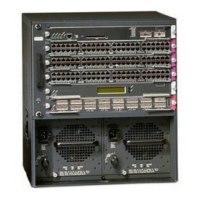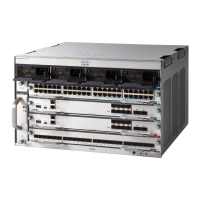Air Flow
The switch is designed to be installed in an environment where there is a sufficient volume of air available to
cool the supervisor engines, modules, and power supplies. If there are any constraints with regard to the free
flow of air through the chassis, or if the ambient air temperature is elevated, the switch environmental monitor
may then shut down the system to protect the system components.
To maintain proper air circulation through the switch chassis, we recommend that you maintain a minimum
space of 6 inches (15 cm) between a wall and the chassis air intake or a wall and the chassis hot air exhaust.
In situations where the switch chassis are installed in adjacent racks, you should allow a minimum space of
12 inches (30.5 cm) between the air intake of one chassis and the hot air exhaust of another chassis. Failure
to maintain adequate spacing between chassis may cause the switch chassis that is drawing in the hot exhaust
air to overheat and fail.
If you are installing your switch in an enclosed or partially enclosed rack, we strongly recommend that you
verify that your site meets the following guidelines:
•
Verify that there is a minimum of 6 inches (15 cm) of clearance between the sides of the rack and both
the chassis air intake grill and the chassis air exhaust grill.
•
Verify that the ambient air temperature within the enclosed or partially enclosed rack is within the chassis
operating temperature limits. After installing the chassis in the rack, power up the chassis and allow the
chassis temperature to stabilize (approximately 2 hours). Measure the ambient air temperature at the
chassis air intake grill and at the chassis air exhaust grill by positioning an external temperature probe
approximately 1 inch (2.5 cm) away from the grills, in line with the chassis slot occupied by a supervisor
engine.
•
If the ambient intake air temperature is less than 104°F (40°C), the rack meets the intake air
temperature criterion.
•
If the ambient intake air temperature exceeds 104°F (40°C), the system might experience minor
temperature alarms and is in danger of overheating.
•
If the ambient intake air temperature equals or is greater than 131°F (55°C), the system will
experience a major temperature alarm and shut down.
•
Verify that the enclosed or partially enclosed rack allows an adequate flow of air through the switch
chassis as follows:
•
If the difference between the measured intake air temperature and the exhaust air temperature does
not exceed 10°C, there is sufficient airflow in the rack.
•
If the difference in air temperature exceeds 10°C, there is insufficient airflow to cool the chassis.
Determine the 10°C temperature difference between the intake and the exhaust by taking
measurements using external digital temperature probes. Do not use the chassis internal
temperature sensors to measure the temperature difference.
Note
•
Plan ahead. A switch that is currently installed in an enclosed or partially enclosed rack might meet
ambient air temperature and air flow requirements at present. However, if you add more chassis to the
rack or more modules to a chassis in the rack, the additional heat generated might cause the ambient air
temperature within the rack to exceed 104°F (40°C) and may cause minor alarms.
Cisco Catalyst 6807-XL Switch Hardware Installation Guide
OL-30656-01 15
Preparing for Installation
Air Flow
